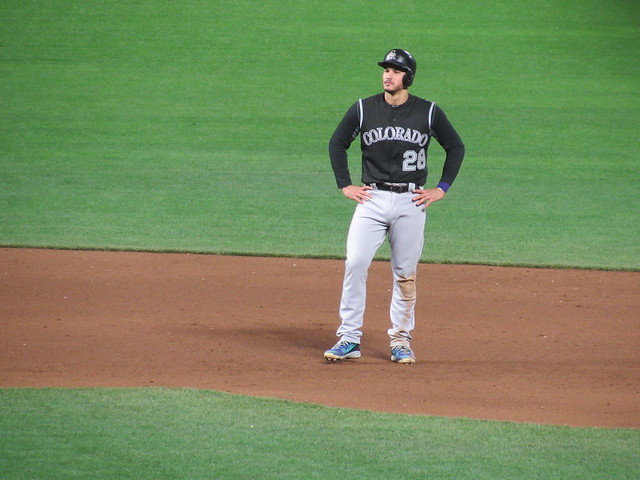Below is an analysis of the prospects in the farm system of the Colorado Rockies. Scouting reports are compiled with information provided by industry sources as well as from our own (both Eric Longenhagen’s and Kiley McDaniel’s) observations. For more information on the 20-80 scouting scale by which all of our prospect content is governed you can click here. For further explanation of the merits and drawbacks of Future Value, read this.
All of the numbered prospects here also appear on The Board, a new feature at the site that offers sortable scouting information for every organization. That can be found here.
Other Prospects of Note
Grouped by type and listed in order of preference within each category.
Upper-level Power Hitters
Vince Fernandez, OF
Casey Golden, OF
Josh Fuentes, 3B/1B
Brian Mundell, 1B
Take a good long look at this group because this is where both Mike Tauchman and Garrett Cooper would likely have been in a purely heuristic version of this list the last few years. The Rockies have had viable big league bats lurking at Triple-A and the Yankees pilfered both of them. Fernandez was suspended for amphetamine usage last year and he only hit .235 with two dingers after he returned. We’re still on him as a 55 raw power corner guy who walks and hits the ball in the air a lot, but he’s gotta come out of the gate hot in 2020 or he’s falling off the list. Golden has 77 homers in two and a half pro seasons but he’s also striking out a third of the time and is 25 years old. Fuentes might be a corner bench bat, but his power output was down last year and he needs to bounce back. Mundell has plus raw but lacks the positional versatility to be a role player.
Hard-throwing Dudes
Raymells Rosa, RHP
Justin Lawrence, RHP
PJ Poulin, LHP
Alexander Martinez, RHP
Juan Mejia, RHP
Salvador Justo, RHP
Boby Johnson, RHP
Mike Nikorak, RHP
There are lots of these guys in the system. Rosa is on track to be a low 40 FV once he’s at the upper levels since he has middle relief stuff. Lawrence is an upper-90s sidearmer with very poor pitch execution. Poulin is another UConn fireballer with a violent, low-slot delivery. Martinez will touch 97 and has a plus curveball, but he’s arguably a 30 athlete and has been old for his level the last two years. Mejia has a great arm action and has been into the upper-90s as a teenager, but he has 30-grade control. Justo is a fastball-only guy in his mid-20s, but he touches 100. Boby Johnson spent two years at Fort Scott Community College before he ended up at Bradley and was finally seen. He’s a pretty athletic 91-96 and throws a ton of strikes. Nikorak’s velo is back after Tommy John, but it doesn’t really play.
Young Sleepers
Bladimir Restituyo, CF
Walking Cabrera, OF
Yolki Pena, OF
Francisco Palma, OF
These are all frame-based projection lottery tickets, though Restituyo is also a 70 runner who might be an impact defender in center one day. The others are corner guys whose bodies and swing development should be monitored.
Depth Starters
Jared Horn, RHP
Nick Bush, LHP
Mitch Kilkenny, RHP
Horn has had a rough couple of years due to family tragedy and an emergency surgery that derailed the early part of his draft spring. At his best, he’ll touch 95 (he was up to 97 in high school), and flash a plus curveball and serviceable change and slider. Bush is a vertical arm slot lefty whose fringe fastball velocity plays up due to deception, and his curveball has terrific depth. He has a passable change that could help make him a spot starter. Kilkenny is coming off of surgery.
System Overview
This system is very heavy on corner bats because the club seems to be pretty good at picking them. There has to be some amount of consolidation of the infielders in this org, and probably soon. You can clearly see the layers of this farm the way you can in a well-made biscuit. The top is comprised of hitters, the bottom full of recently-acquired arms. Why so few up near the top with the other mature, or potential long-term impact talents? Well, so many of the pitchers Colorado has drafted over the last several years have either gotten hurt, been bad, or both. David Hill, Javier Medina, Nikorak, Kilkenny, Pint, Tyler — it’s a long list of pitchers who either have gotten hurt or fallen short of even modest expectations. Some of the very recent developments (Goudeau, Rolison) and acquisitions indicate improvement, but let’s wait a bit to see what kind of results this farm yields. It’s got to be tough to try to build a talent pipeline meant to fit your big league ballpark’s unique hitting environment, but the vanilla college pitchability guys just aren’t working.
We have to preface this by reminding you that Eric lives in Arizona and is horribly biased because he wants to see more players, but why the heck don’t the Rockies have an AZL team? Their exciting group of teenage hitters spent their summer facing college pitching when they’d probably have been better off against same-aged pupils in Arizona. There’s no evidence to which we can point that justifies this approach, and aside from Raimel Tapia, this org has struggled to develop homegrown players from Latin America who are all asked to jump right from the DSL to Advanced Rookie ball.

